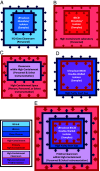Mars Sample Return: From collection to curation of samples from a habitable world
- PMID: 39761397
- PMCID: PMC11745348
- DOI: 10.1073/pnas.2404253121
Mars Sample Return: From collection to curation of samples from a habitable world
Abstract
NASA's Mars 2020 mission has initiated collection of samples from Mars' Jezero Crater, which has a wide range of ancient rocks and rock types from lavas to lacustrine sedimentary rocks. The Mars Sample Return (MSR) Campaign, a joint effort between NASA and ESA, aims to bring the Perseverance collection back to Earth for intense scientific investigation. As the first return of samples from a habitable world, there are important challenges to overcome for the successful implementation of the MSR Campaign from the point of sample collection on Mars to the long-term curation of the samples on Earth. In particular, the successful execution of planetary protection protocols adds well-warranted complexity to every step of the process from the two MSR Program flight elements to the ground element at the sample receiving facility (SRF). In this contribution, we describe the architecture of the MSR Campaign, with a focus on infrastructure needs for the curation (i.e., the clean storage, processing, and allocation) of pristine Martian samples. Curation is a science-enabling and planetary protection-enabling activity, and the curation practices described in this contribution for the SRF and any long-term curation facility will enable the sample safety assessment, initial scientific investigations of the samples, and establish the MSR collection as a scientific resource that will enable generations of science and discovery through studies of the returned Mars samples. The planetary protection and curation processes established for MSR will provide critical insights into potential future sample return missions from other habitable worlds like Enceladus and Europa.
Keywords: Jezero Crater; Martian; astrobiology; astromaterials; planetary protection.
Conflict of interest statement
Competing interests statement:The authors declare no competing interest.
Figures



References
-
- Canup R. M., Asphaug E., Origin of the Moon in a giant impact near the end of the Earth’s formation. Nature 412, 708–712 (2001). - PubMed
-
- Lock S. J., et al. , The origin of the Moon within a terrestrial synestia. J. Geophys. Res.-Planets 123, 910–951 (2018).
-
- Wood J. A., Dickey J. S., Marvin U. B., Powell B. N., Lunar anorthosites. Science 167, 602–604 (1970). - PubMed
-
- Smith J. V., Anderson A. T., Newton R. C., Olsen E. J., Wyllie P. J., A petrologic model for the Moon based on petrogenesis, experimental petrology, and physical properties. J. Geol. 78, 381–405 (1970).
-
- Connelly J. N., et al. , The absolute chronology and thermal processing of solids in the solar protoplanetary disk. Science 338, 651–655 (2012). - PubMed
LinkOut - more resources
Full Text Sources
Research Materials
Miscellaneous

